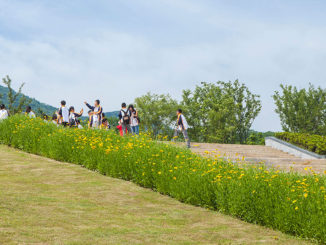There have always been several types of landscape architecture programs that are often either grounded in garden design or applied science, or conceptual design. The delineation between the various programs is not clear cut. Some programs can straddle across two or several typologies as landscape architecture is often the study of art, nature and science.
There is growing disquiet among practitioners that graduates often lack understanding of core topics, including soils, plants, ecology, construction technology and the ability to deal with small scale design. Over the past decade, landscape architecture programs have placed greater emphasis on teaching topics such as landscape urbanism, climate change, and resilience to improve graduates knowledge and understanding of these issues. Many programs have also increased the amount of time spent learning to create 3D representations and data analysis with different software, technology and data analysis. This change in direction teaches graduates to explore some of the challenges facing the world and learning new technologies profession; however, some programs are over-emphasising their focus on these topics and possibly neglecting the core principles and areas of knowledge that landscape graduates need when venturing out into the profession.
When looking at many of the design presentations from the university studios, we can see that there is increasingly a move towards large scale design projects and “big move” responses to design issues. I applaud that universities are tackling these topics and empowering students to explore the problems and provide solutions. However, it is becoming apparent that some universities are concentrating most or all of their design studios (and subjects) on large scale analysis & design and whilst utilising all technologies available. Many practitioners feel that too much time is spent perfecting the art of the perspective render and plans rather than learning to analyse scale, spaces, and the ability to resolve design issues quickly through case studies and small scale design projects.
Firms are taking on environmental and social issues to move the landscape industry towards a more sustainable future; however, only a few firms have the ambition, reputation, clients, and qualifications/certifications to tackle large-scale projects (waterfronts, green/blue infrastructure and urban redevelopment, etc). Of course, many firms partner together with other landscape architects or multi-discipline firms to tackle these projects. Still, most landscape architecture firms deal with small to medium scale residential, urban or periurban projects that often are constrained by their boundaries. The majority of firms are doing their best to have an environmental impact at every scale, but it is usually not working on large scale “big move” design projects addressed in university programs.
Universities are tailoring programs with an environmental focus to attract more students, especially those who are more interested in dealing with large scale environmental issues. However, graduates from these environmentally-focused programs can become disheartened in their first few years in the profession as they realise that the profession they studied is not as they thought it would be. They often begin to realise that landscape architects spend a large portion of their time managing people (clients, stakeholders, contractors, etc.) and negotiating and resolving issues and spend a minority of their time designing. This problem is not unique to landscape architecture, but it can be challenging for graduates to work through these realisations. The needs to be more time spent in university programs to provide students with some understanding of collaboration, community consultation along with managing projects and people.
Anecdotally some firms are having to train graduates on the core skills of the landscape profession whilst at the same time dealing with graduate aspirations to be solving large scale environmental problems. This can be a problem for both employers and graduates as employers seek to service work efficiently whilst retaining graduates at the same are trying to resolve their employee’s aspirations to create a bigger impact.
Universities, firms, and associations need to come together to evaluate programs and ascertain if it meets the core needs of the landscape architecture profession. Of course, there is no denying that universities and academia need to innovate and move thinking and the profession forward; however, there needs to be a set of subjects that address the core principles and areas of knowledge of the profession. It may be that some programs need to create new programs (as some have done) to cater to students who wish to explore landscape urbanism, urban design and environmental issues.
The profession needs to become vocal and participate in evaluating and accreditation of programs whilst realising that landscape programs need to appeal to students with subjects that explore ideas and concepts. They also need to become more involved in teaching the programs as sessional staff and presenters. The profession also needs to reduce its thirst for graduates who are instantly ready to work in their firms. There has always been a learning curve for graduates, and there is a need for firms to train and mentor new graduates through the early years of their careers to ensure that they stay in the profession and become great designers and landscape architects.
Do university programs need to be rebalanced? The debate will be never-ending between the profession and academia about design, approaches, innovation and the curriculum. There is an opportunity for universities and the profession to work together to seek a balance between programs that appeal to students with subjects that explore significant design issues along with new technologies whilst providing subjects that teach the core skills required to be a landscape architect. Landscape architecture is a generalist profession, and there is a need for graduates to have a broad understanding of landscape architecture whilst universities still need to explore new ideas and issues. It is a fine balance that universities and the profession will need to continually work on to achieve.
Is there a need to rebalance landscape architecture programs? was written by Damian Holmes, Founder and Editor of WLA. A registered Landscape Architect with over 20 years of experience.
Email damian@worldlandscapearchitect.com if you would like to discuss the above article.
Image Credit used for Cover:
Did you like reading this article? We are committed to publishing more landscape architecture projects and articles like this one. We encourage you to become a WLA Supporter to support us in continuing to publish great content.
DISCLAIMER: This article is for educational purposes only. The content is intended only to provide a summary and general overview on matters of interest. It’s not intended to be comprehensive, nor to constitute advice. You should always obtain legal or other professional advice, appropriate to your own circumstances, before acting or relying on any of that content. This advice is general in nature.



